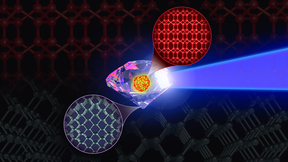NIF sets new laser energy record
 (Download Image)
NIF’s target chamber is where the magic happens -- temperatures of 100 million degrees and pressures extreme enough to compress the target to densities up to 100 times that of lead are created there. Photo by Jason Laurea/LLNL
(Download Image)
NIF’s target chamber is where the magic happens -- temperatures of 100 million degrees and pressures extreme enough to compress the target to densities up to 100 times that of lead are created there. Photo by Jason Laurea/LLNL
Lawrence Livermore National Laboratory’s (LLNL) National Ignition Facility (NIF) laser system has set a new record, firing 2.15 megajoules (MJ) of energy to its target chamber -- a 15 percent improvement over NIF’s design specification of 1.8 MJ, and more than 10 percent higher than the previous 1.9 MJ energy record set in March 2012.
This demonstration shot successfully meets a National Nuclear Security Administration (NNSA) Level 2 milestone for 2018. NIF, the world’s largest and most energetic laser, is funded by NNSA to serve as a critical research facility supporting the U.S science-based Stockpile Stewardship Program (SSP).
"NIF’s users are always asking to use more energy in their experiments, because higher energies enhance the science NIF can deliver in support of the stewardship program. These results mark a major step toward increasing NIF’s energy and power capability," said NIF Director Mark Herrmann. "This demonstration serves as the first step on a path that could allow NIF to operate at substantially higher energies than ever envisioned during NIF’s design."
The purpose of this experiment was to demonstrate the highest energy NIF can safely deliver with its current optics and laser configuration. Increasing NIF’s energy limit will expand the parameter space for stewardship experiments and provide a significant boost to the pursuit of ignition -- a key element of NNSA’s Stockpile Stewardship Program.
This work builds on a successful demo laser campaign performed on NIF last year, which utilized just four of NIF’s beams to study the performance limits of the NIF laser. Recently published in Nuclear Fusion, the experimental campaign was designed to assess laser performance limits and operational costs against predictive models. The campaign culminated in the delivery of the highest energies to date and informed the effort to demonstrate 2.1 MJ on the entire 192-beam laser system.
"The successful 2.1 MJ demonstration is the result of a sustained science and technology investment in NIF and fundamental understanding of optical damage, much of which has been supported by Laboratory Directed Research & Development (LDRD) and other institutional programs," said NIF & Photon Science Principal Associate Director Jeff Wisoff.
The NIF laser uses tens of thousands of large precision optical components, including lenses, laser glass slabs, mirrors and frequency conversion crystals to amplify and guide 192 laser beams to a small target in the 10-meter target chamber. Continuous research and development efforts have put these optics at the cutting edge of material science and technology and play a crucial role in raising the laser’s energy and power thresholds. Recent breakthroughs have reduced the level of damage initiation and growth in the optics and led to a reduced cost to mitigate existing damage spots.
Based on this successful demonstration, NIF is working with LLNL’s ignition program to execute the first ignition experiments that utilize this enhanced energy capability later this summer. Looking ahead, this is the first major step toward extending NIF’s energy and power output through technology development and laser research to extend the NIF mission space and its contributions to the SSP.
Contact
 Breanna Bishop
Breanna Bishop
[email protected]
(925) 423-9802
Related Links
NIFStockpile Stewardship Program
National Nuclear Security Administration
Nuclear Fusion
"Lab scientists develop next-generation NIF optics to boost energy and limit damage"
Tags
Nuclear deterrenceStockpile stewardship
NNSA
National Ignition Facility and Photon Science
National Ignition Facility
Lasers and Optical S&T
Lasers
Featured Articles







